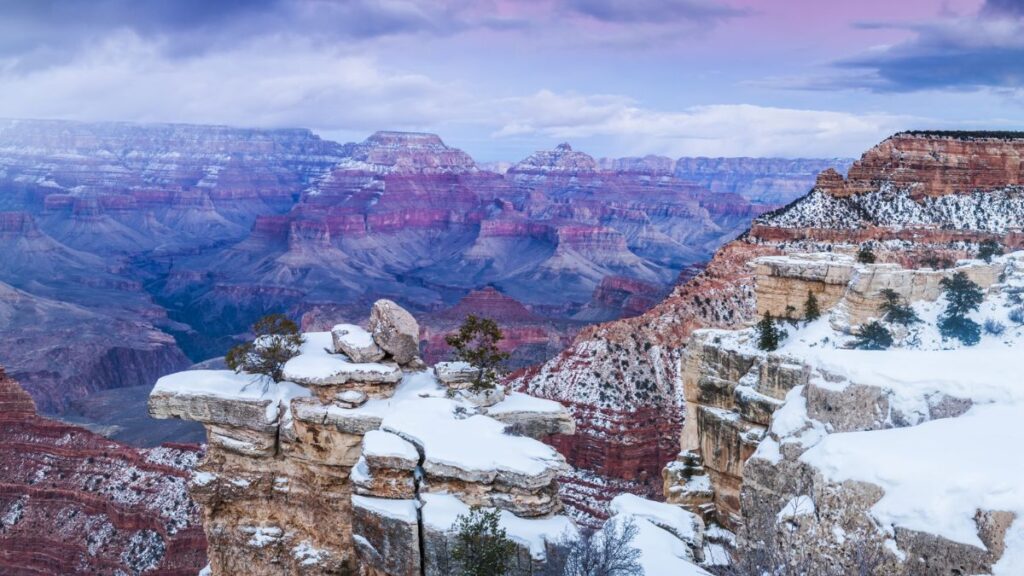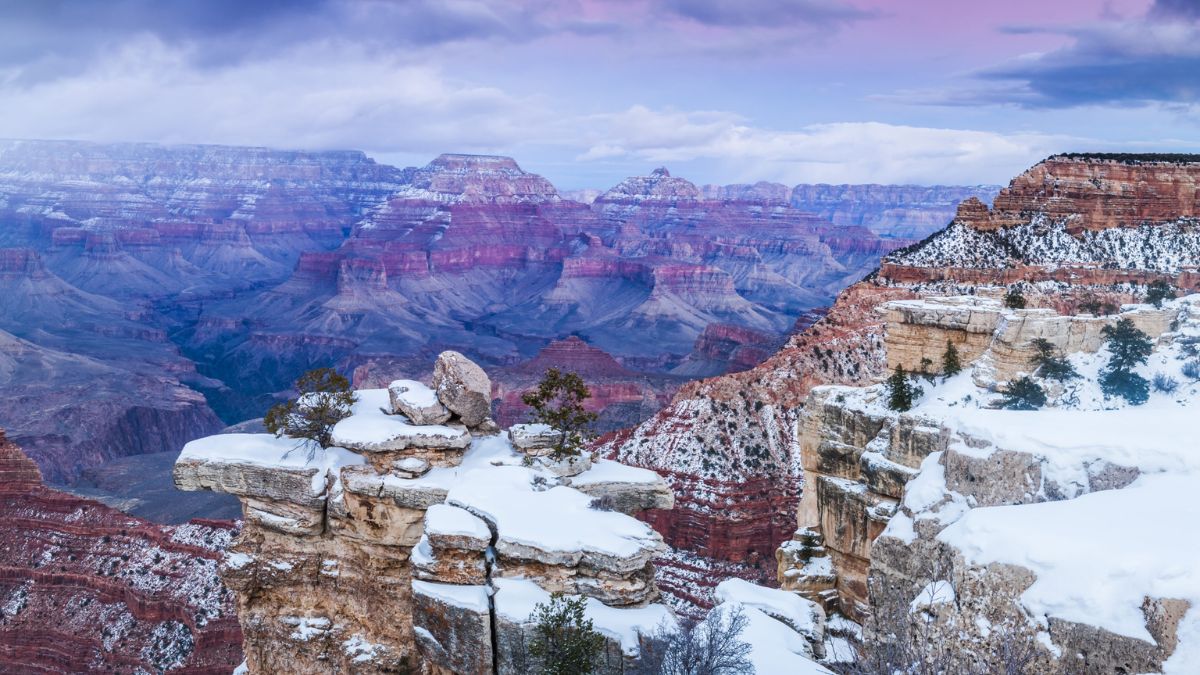Yes, it does snow in the Grand Canyon. The North Rim of the Grand Canyon, which is at a higher elevation than the South Rim, receives more snowfall. However, it is important to note that the amount of snowfall can vary significantly from year to year, depending on weather patterns and other factors.
The Grand Canyon in Arizona experiences winter weather conditions that can bring snowfall, particularly at higher elevations and during the winter months. On average, the North Rim receives about 150 inches of snow each year, while the South Rim receives around 60 inches.

The Grand Canyon is one of the most iconic natural wonders in the United States. It attracts millions of visitors annually with its breathtaking views and geological marvels. Known for its immense size and beauty, the Grand Canyon experiences various weather conditions throughout the year.
One question that often arises is whether or not it snows in the Grand Canyon. In this article, we will explore this intriguing question and shed light on the snowy side of this majestic landmark.
Location Overview
Location Overview
The Grand Canyon is one of the world’s most remarkable natural wonders. It is located in the southwest of the United States. Here is an overview of the Grand Canyon’s location and its surrounding areas:
- State
The Grand Canyon is situated in the state of Arizona. It covers a vast area within the northwestern part of the state.
- National Park
The Grand Canyon National Park, which was established in 1919, is encompassed most of the Grand Canyon. The park covers an area of approximately 1.2 million acres. The National Park Service manages it and attracts millions of visitors annually.
- Geological Formation
The Grand Canyon was carved by the Colorado River over millions of years. It is located within the Colorado Plateau, a region characterized by its diverse geology, including layers of sedimentary rocks, ancient lava flows, and dramatic cliffs.
- South Rim
The South Rim is the more popular and accessible side of the Grand Canyon. It is located in Grand Canyon Village, approximately 60 miles north of the town of Williams, Arizona.
The South Rim offers numerous viewpoints, visitor centers, lodges, and amenities. It is open year-round and provides stunning panoramic views of the canyon.
- North Rim
The North Rim is less visited but equally breathtaking. It is situated about 10 miles south of the Utah-Arizona border. The North Rim is at a higher elevation than the South Rim, reaching over 8,000 feet above sea level.
Due to its higher elevation, the North Rim experiences a shorter visitor season, typically from mid-May to mid-October. It offers a more remote and tranquil experience, with fewer crowds and a cooler climate.
- Surrounding Areas
Several other noteworthy landmarks and attractions surround the Grand Canyon:
- Kaibab National Forest
- Havasu Falls
- Glen Canyon National Recreation Area
- Horseshoe Bend
The Grand Canyon is located in Arizona and encompasses a significant portion of the state’s northwestern region. It is divided into the South Rim and the less-visited North Rim, both of which offer spectacular views and a range of visitor facilities.
Geography and Climate of The Grand Canyon
The Grand Canyon is situated at a higher elevation compared to many other parts of the state. The elevation plays a significant role in shaping the climate of the area.
The canyon’s rim ranges in elevation from around 7,000 to 8,000 feet above sea level, while the inner canyon floor is at a lower elevation, approximately 2,000 to 5,000 feet. This variation in elevation contributes to distinct weather patterns throughout the region.
Historical Snowfall Record
The Grand Canyon has a varied climate, and snowfall is one of the weather phenomena that can occur in the winter months. However, it is important to note that historical snowfall records for the Grand Canyon are not easily accessible or well-documented.
The National Park Service, which manages the Grand Canyon National Park, does not provide comprehensive historical snowfall data for the area. Local weather stations and nearby communities may have some historical snowfall data, but it may not be specifically focused on the canyon itself.
The nearby town of Flagstaff, Arizona, which is located at a higher elevation and experiences more consistent winter snowfall, often serves as a reference point for snowfall records in the region.
Winter Season & Snowfall Pattern
Winter in the Grand Canyon can bring chilly temperatures and, in some areas, snowfall. The North Rim of the Grand Canyon, with a higher elevation than the South Rim, experiences colder weather and heavier snowfall. The North Rim’s elevation makes it more susceptible to wintry conditions.
Factors Influencing Snowfall
Several factors influence snowfall in the Grand Canyon, including elevation, topography, air masses and storm tracks, weather systems, climate oscillations, and annual variability. These factors interact to determine the amount and distribution of snowfall in the region.
However, predicting snowfall accurately can be challenging, and historical snowfall records of this area may be limited.
Locations to Enjoy Snow
When snow blankets the Grand Canyon, it transforms into a winter wonderland, presenting visitors with a unique and breathtaking experience. The canyon’s red and orange rocks and the pristine white snow create a stunning contrast that photographers and nature enthusiasts find captivating.
While the Grand Canyon is not typically associated with heavy snowfall throughout its entire expanse, there are nearby locations where visitors can enjoy snowy experiences during winter. Here are a few areas near the Grand Canyon where you can enjoy the snow:
- North Rim of the Grand Canyon
The North Rim receives more snowfall than the South Rim, The surrounding areas within the Kaibab National Forest offer opportunities for winter activities such as cross-country skiing, snowshoeing, and snowmobiling.
- Flagstaff, Arizona
Located about 80 miles southeast of the Grand Canyon, Flagstaff is known for its winter weather and receives significant snowfall. The Coconino National Forest surrounds the city, which offers various winter outdoor activities. The Arizona Snowbowl, a popular ski resort, is located just outside of Flagstaff.
- Williams, Arizona
Situated about 60 miles south of the Grand Canyon, Williams experiences colder temperatures and occasional snowfall during winter. The town provides a charming winter atmosphere with festive decorations, cozy shops, and opportunities for outdoor activities.
- Jacob Lake
Located approximately 44 miles north of the North Rim, Jacob Lake is a small community known for its proximity to the Kaibab National Forest. The forest offers opportunities for winter recreation, including cross-country skiing and snowmobiling.
It’s important to note that some winter activities may require proper equipment and knowledge of winter safety precautions.
Conclusion
While the Grand Canyon is renowned for its warm and arid climate, it does experience snowfall during winter, particularly at higher elevations. With its greater elevation, the North Rim receives more snow than the South Rim.
Snowy landscapes offer a unique and captivating perspective of the canyon, allowing visitors to witness its grandeur in a different light. So, if you are planning a visit to the Grand Canyon during the winter, don’t forget to pack your winter gear and prepare for a memorable snowy adventure.
